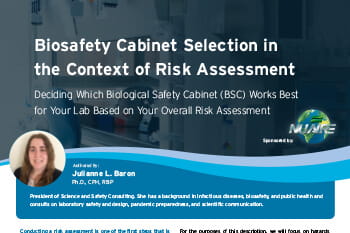
White Paper
Biosafety Cabinet Selection in the Context of Risk Assessment
The white paper "Biosafety Cabinet Selection in the Context of Risk Assessment" provides invaluable guidance for laboratories handling hazardous materials. It emphasizes the critical role of conducting a thorough risk assessment before selecting a biological safety cabinet (BSC). This comprehensive approach ensures that the chosen BSC aligns perfectly with the lab's specific needs and safety requirements.
A risk assessment evaluates the likelihood and consequences of exposure to various hazards, such as biological, chemical, radiological, and physical threats. The process involves a detailed analysis of the hazards associated with specific agents and laboratory procedures, implementation of control measures, and ongoing review of remaining risks. A knowledgeable team, including leadership and subject matter experts, should conduct this assessment.
The white paper discusses the importance of understanding the different classes and types of BSCs, such as Class I, Class II, and Class III, each offering varying levels of protection. Class I cabinets provide essential protection, similar to chemical fume hoods, but with HEPA-filtered exhaust. Class II cabinets, which include types A1, A2, B1, B2, and C1, offer personnel, environmental, and product protection with HEPA-filtered supply and exhaust air. Class III cabinets provide the highest level of protection, with gas-tight construction and dual HEPA-filtered exhaust.
Based on the risk assessment, the paper outlines how to match the BSC type to the lab's requirements. For instance, Class II, Type A2 cabinets are versatile and can handle most biological work. In contrast, Class II, Type B2 cabinets are necessary for hazardous chemical work due to their 100% exhausted air system.
Additionally, the document highlights the importance of proper installation, maintenance, and certification of BSCs to ensure they continue providing the required protection level. It advises consulting with BSC manufacturers for model-specific features and support but cautions that the final selection should be based on the lab's detailed risk assessment.
The white paper provides a comprehensive guide for lab managers and safety officers, providing detailed information on risk assessment, BSC selection, and integrating these cabinets into the lab's overall safety strategy. By following the recommendations and best practices outlined in this white paper, labs can significantly enhance their safety protocols, ensuring personnel safety and scientific work's integrity.

